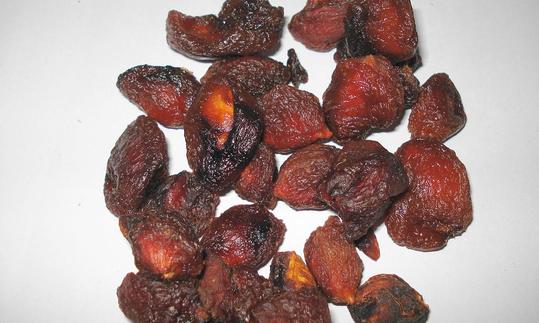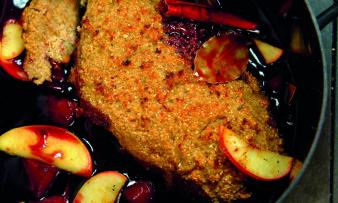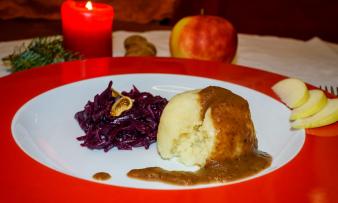Table of contents
Dried plums, also known as prunes / dried plums called prunes contain a lot of sugar and are therefore very sweet. Organically produced dried plums in raw food quality are a practical snack that is good for digestion.
Use in the kitchen
Dried plums are usually made from the noble plum. They have a deep blue-black skin. They should not be confused with dried fruit made from damsons. When the plums are dried, the aromatic substances are concentrated, which gives them a more intense taste than fresh plums.
They taste delicious as a snack between meals or chopped up in muesli. They are great for fruit bread, fruit slices or energy balls. Covered in chocolate and filled with nuts, they make a delicious dessert. Simmered gently over a low heat with a little water and refined with cinnamon, cardamom or vanilla, you can easily make a compote. Dried plums are also often used to make sauces (plum sauce), for example for a red wine and plum sauce or a vegan gravy with dried plums. As an alternative to sugar, honey and dates, plums can be used to sweeten desserts, cakes or creams.
Vegan recipe for plum energy balls
Ingredients (for approx. 30 pieces): 100 g chestnuts, 50 g walnuts, 100 g dried plums, 1 tbsp cocoa powder (unsweetened), 2 tbsp tahini (sesame butter), 15 g amaranth, puffed.
Preparation: Finely chop the chestnuts, walnuts and plums and puree them with cocoa powder and tahini in a high-performance blender. Divide the mixture into 30 portions and form into small balls. Place the amaranth on a flat plate and roll the balls in it. To store the energy balls, fill them into screw-top jars or storage containers. They will keep for up to a week if kept in the fridge.
Vegan recipes with dried plums can be found under the note: " Recipes that have the most of this ingredient ".
| Not only vegans or vegetarians should read this: Vegans often eat unhealthily. Avoidable nutritional errors. |
Purchasing - Storage
Dried plums can often be found in the range of large supermarket chains such as Coop, Migros, Denner, Volg, Spar, Aldi, Lidl, Billa, Rewe, Edeka or Hofer, occasionally also in controlled organic quality (organic quality). Dried plums can also be bought in organic supermarkets such as Denn's Biomarkt or Alnatura. Dried plums are available all year round.
For health reasons, unsulfured dried plums without sugar (unsweetened) should be preferred. Organic dried fruit also contains fewer pesticides. Temperatures of 60-70 °C are often used for industrial drying (see Industrial Production). Dried plums in raw food quality must therefore be specially labeled.
The availability of dried plums varies depending on the size of the store, catchment area, etc. Our recorded food prices for the DA-CH countries can be found above under the ingredient image - and by clicking on them you can see their development at various suppliers.
Homemade preparation
Uncooked and unsulphured dried plums are easy to make yourself. To do this, you should remove the stones from the plums. You can gently dry them at a low heat, either chopped up, whole or in large pieces. Suitable tools are the oven or dehydrators. Hanging the plums on a string or drying them on a rack (e.g. in the attic) are natural and traditional methods. Sun drying works in the open air on an air-permeable surface such as gauze or cotton muslin.
Storage tips
Dried plums should be stored like other dried fruit in a container (screw-top jar) in an airtight, dry, cool place and protected from sunlight. This way they can be kept for up to a year. 4
Ingredients - Nutritional Value - Calories
Raw dried plums have a much higher energy density than the same amount of fresh plums. The drying process also changes the nutrient composition. Interestingly, plums are a strong source of energy in the form of simple sugars, but do not cause a rapid increase in blood sugar concentration, possibly due to the high fiber, fructose and sorbitol content. 13
Dried plums (organic) contain 240 kcal per 100 g. They are very high in sugar. 100 g of dried plums contain 38 g of sugar. They are low in fat and protein, with 0.38 g of fat and 2.2 g of protein per 100 g. The carbohydrate content is 64 g and the fiber content is 7.1 g per 100 g. 1
The vitamin K content is remarkable. The 60 µg/100 covers 79.0% of the daily requirement. This is high for fruit. In comparison, green kiwi has 40 µg and rhubarb 29 µg per 100 g. Green vegetables such as kale (705 µg) and chard (830 µg) have high vitamin K values. 1
Potassium is abundant at 732 mg per 100 g. This corresponds to 37.0% of the daily requirement. This is comparable to raisins (749 mg/100g) or dried sour cherries (798 mg/100g). A lot of potassium is contained in spices and herbs, as well as in dried porcini mushrooms (2000 mg/100g). 1
Prunes also contain small amounts of vitamin B6 (pyridoxine),riboflavin (vitamin B2), niacin (vitamin B3), as well as manganese and magnesium.
The complete ingredients of dried plums, the coverage of the daily requirement and comparison values with other ingredients can be found in our nutrient tables. In the article Nutrients explained you will get a detailed insight into the topic.
Health effects
Prunes are an old home remedy for constipation and diarrhea. The health claim that prunes can help maintain healthy bowel function has now been officially confirmed by the European Commission . 8 Dried plums soften the stool, increase its mass and thus stimulate bowel movement. 13 This effect is usually attributed to the high fiber content and the phenolic compounds they contain. 6 The plant fibers swell in the intestines and thus stimulate digestion.
However, since the effect has also been demonstrated when consuming plum juice, it is now assumed that the effect is due to the sorbitol. 12 plums or 1 cup of plum juice contain enough sorbitol (sorbitol content) to achieve the desired effect. 13 Eating prunes could help prevent colon cancer. Animal studies show that harmful factors decreased with regular consumption. 7
Dried plums can contribute to bone health. They contain calcium, magnesium, phosphorus, copper and boron, all of which are necessary for building bones. They can therefore help prevent and treat osteoporosis. One serving of prunes (100 g) covers the daily requirement of boron (2 to 3 mg). 13 Dried plums are also rich in potassium. 1 A diet rich in potassium can have a blood pressure-lowering effect. High blood pressure (hypertension) is one of the most well-known risk factors for cardiovascular disease and stroke. 10 Eating prunes in moderate amounts (due to their high sugar content) can be a good addition to a diet rich in potassium. 13
Recent research shows that prunes have the highest antioxidant content of any plant-based food (followed by raisins andblueberries). Antioxidants neutralize free radicals and thus protect against oxidative stress, which can lead to health problems and cancer. 13
Folk medicine - natural healing
Prunes as a home remedy for constipation:
Soak eight to twelve prunes in water for a few hours (5 to 10), overnight is also possible. Then eat them including the soaking water - about a cup. To avoid stomach pain or flatulence, you should not eat more than this amount. How many grams does a dried plum weigh? This varies greatly and is eight to twelve per 100 g. You can also do this treatment for several days in a row, rather than too many at once. A fresh, pitted plum weighs around 35 g.
Dangers - Intolerances - Side effects
People who are allergic to birch pollen or peaches can have an allergic reaction to plums. If it is a cross-reaction to the birch pollen fruit protein (birch fruit syndrome), you can eat cooked plums, as the allergen is not heat-stable. However, if you are intolerant to peaches and plums, a heat-stable protein is responsible. Cooking the fruit does not alleviate the symptoms. In addition, these are usually more severe than with a birch pollen fruit allergy. 11
Sulphurized prunes can be dangerous for asthmatics and allergy sufferers and can trigger severe allergic reactions. 9 If you are intolerant to sorbitol, you should avoid dried plums, prunes, prunes or damsons. Plum juice, for example, contains between 6 and 14.7 g/100 g of sorbitol. This has a laxative effect, as does the large amount of phenolic compounds (184 mg/100 g), especially neochlorogenic acid and chlorogenic acid. 13
The sugar substitute sorbitol is hidden in the ingredients list behind the E number E 420. Other E numbers containing sorbitol include E 432, E 433, E 434, E 435 and E 436. Other sugar substitutes such as xylitol (E 967 or birch sugar), mannitol (E 421), isomaltitol / palatinit (E 953), maltitol (E 965) and lactitol (E 966) are not sorbitol, but lead to the same symptoms in larger quantities. 13
Since dried plums have practically the highest density of sorbitol, here is a comparison with other fruits that have more than 1 g/100g: dried plums 6.57, dried peaches 5.33, dried apricots 4.6, dried apples 2.49, pears 2.17, plums 1.4, dried dates 1.35. 16
Ecological footprint - animal welfare
Plums themselves are a climate-friendly food with a small CO 2 footprint of 0.32 kg CO2eq/kg. 18 However, the drying process is usually very energy-intensive. A study on the sustainability of dried plums found a CO 2 footprint of 2.07 kg CO 2 eq/kg of sliced prunes. The pure horticultural production of the plum only came to 0.7 kg CO2eq/kg. 17 Carboncloud, a Swedish climate information platform, has made a calculation from publicly available data for pitted dried plums from California: the production of dried plums could emit 4.00 kg CO 2 eq/kg. 20
We could hardly find any data on the water footprint of dried plums. The website ' Water Footprint Calculator ' gives a water footprint of 6245.84 l/kg for dried plums - which the authors (unfortunately without mentioning their names) classify as a large water footprint. 21 Mekonnen and Hoekstra, two important scientists in this field, arrived at a water footprint of 2180 l/kg for plums; this value is far above the global average for fruit (967 l/kg). 19
Dried plums are available all year round. If you want to make your own dried plums, buy them locally and seasonally. Buying seasonal products has a positive impact on the ecological balance. Non-local or out-of-season fruit and vegetables are transported by ship or plane, which greatly increases their ecological footprint. 12
For detailed explanations of various sustainability indicators (such as ecological footprint, CO2 footprint, water footprint), see our article: What does the ecological footprint mean?
Animal welfare - species protection
The use of pesticides is a common practice in industrial fruit growing. Many of these poisons are harmful to farm workers and the environment. The pollutants can contaminate water and are just as harmful to non-target organisms/wild animals. In plum cultivation, 33 pesticides are used that are toxic to pollinators such as honey bees. 22 In a study, however, researchers were able to show that low environmental pollution can very well go hand in hand with high yields. 23
Worldwide occurrence - cultivation
Prunes are usually made from noble plums. The origin of the noble plum ( Prunus domestica var. subrotunda) is not clearly established. It is assumed that it is a hybrid of cherry plum ( Prunus cerasifera) and blackthorn ( Prunus spinosa). 3 According to EU guidelines, they may contain a maximum of 23% moisture. 'Semi-dry prunes' can have a moisture content of 30 to 35%. 5
Today, California (USA) is the main growing area for plums (and prunes) in the world. 6
Information on growing and harvesting plums can be found under the link Plum, raw (true noble plum).
Industrial production
Industrially produced dried plums are hot-air dried at temperatures of around 85-90 °C for around 18 hours. After drying, the plums are sorted by size and pitted. 15
Dried fruit is then often sulphurised and/or treated with preservatives to increase its shelf life. In contrast to apricots, which retain their yellow-orange colour and thus a more appetising appearance due to the sulphurisation, there is no colour difference visible to the naked eye in sulphurised prunes. Sulphurisation is indicated on the packaging with either the addition "E220" or "sulphurised". Controlled organic prunes are produced without the use of sulphur. There are also gently dried plums in raw food quality (drying temperature maximum 42 °C). Natural raw dried plums can also be made at home (see self-preparation). 14
Further information
The common plum ( Prunus domestica var. subrotunda) - the best known of the common plums ( Prunus domestica subsp. italica) - appears in dark red to blue-black. Green-yellow varieties are called greengages ( Prunus domestica var. claudiana). It is a rose plant (Rosaceae), probably originating from a hybrid between cherry plum and blackthorn. 3 There are 7 subspecies of the (cultivated) plum, including the damson and mirabelle.
Different varieties are used to make prunes: Italian plums, French d'Agen plums, Van der Merwe, or Californian plums (usually also a d'Agen variety). Accordingly, there are dried Italian plums, dried d'Agen plums, etc., all of which defend their name. Which fruit is called Prünelle? The Prünelle is a special dried plum. These plums, harvested before they are ripe, are skinned, pitted and then dried and pressed. The creeping plum ( Prunus domestica subsp. insititia), a subspecies of the sweet plum, is often used to make Prünelle.
Alternative names
Dried plums are also called prunes or dried plums. In Austria they are known as dried plums or dried plums. In English, fresh plums are called plums and dried plums are called prunes.











Comments